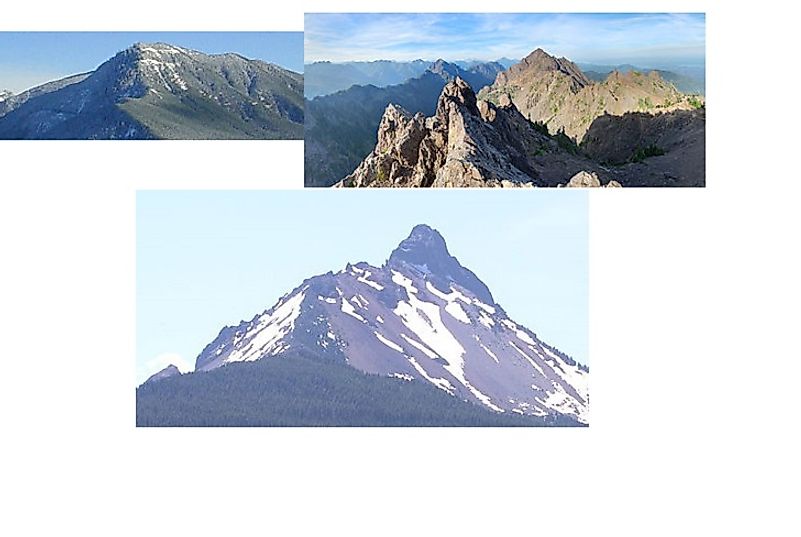Did You Know That The Pacific Northwest Has Four Peaks Each Named Mount Washington?

It’s only normal, rational, and reverent to name geographic features after famous people—such as if that person was the first President of the United States. In fact, it’s fairly common for there even to be different geologic landmarks bearing the exact same name, sometimes even within a single state or province. In the case of the "Mount Washingtons" of the Pacific Northwest, this couldn't be more true.
5. Same Names, Different Places
With a state already named after the “Father of His Country”, it’s only natural for there to be a mountain named in George Washington’s honor. However, in western Washington State alone, there are three peaks bearing the name Mount Washington. The tallest of these three is located on the Olympic Peninsula, within the Skokomish Wilderness located just outside of the Olympic National Park in Mason County, and it is 6255 feet in elevation. The most accessible and popular to hike is located east of Seattle, just south of the Interstate 90, where it is 4,420 feet in elevation. And the smallest, and most obscure, of Washington's Mount Washingtons is located in southern Skagit County between Lake Cavanaugh and Lake McMurray, and it is 2,698 feet in elevation. And if there weren’t enough mountains named after George Washington in Washington State, their neighbor, Oregon, has its own Mount Washington, a heavily eroded and extinct shield volcano that is located within the Mount Washington Wilderness northwest of Bend. This Mount Washington in Oregon is the most dramatic and tallest of the lot at 7,794 feet in elevation.
4. Historical Roles
Since George Washington was so revered in his lifetime, his name lives on in everything from city, county, and state names to quirky pop culture references. In general, geographic features are named in honor of people all of the time, so the locals in the Pacific Northwest do not consider these mountains bearing the same name to be in the least bit excessive. Like the highly generic “Lookout” Mountain, these mountains were all, of course, named at successive times by different people, possibly unaware that another mountain nearby was already given the same title. However, in the case of the Mount Washington east of Seattle, it was originally named Profile Mountain, but was changed because of a cliff on the mountain resembling the profile of George Washington when it was viewed from a certain angle.
3. Modern Significance
The Skagit County Mount Washington is not significant in any way, and in fact even the locals may see the mountain and not even know its name. The Olympic Mount Washington is highly popular with mountaineers and rock climbers for being one of the closest and most accessible of all the Olympic Mountains, while the Seattle-area Mount Washington is popular with day hikers seeking respite, yet still incredible, views of the surrounding area from the more crowded nearby Mount Si. The Oregonian Mount Washington has a relatively simple summit route, which makes this a popular rock climbing and mountaineering destination, with the nearby Pacific Crest Trail only emphasizing its accessibility. And of course, at the foot of that mountain is the appropriately named "George Lake".
2. Habitats and Wildlife
Each of these mountains are within the same region, so they all share a similar climate, and therefore similar wildlife commonly found in the mountains of the Pacific Northwest. This includes Bald eagles, coyotes, Golden-mantled ground squirrels, elk, Blue grouses, Western tanagers, raccoons, beavers, and Black bears. However, the notable features of the Olympic Mount Washington are that, because the mountain is located on the rain shadow side of the Olympic Range and thus receives less precipitation, the tree-line is higher there than in mountains on the oceanic side. Also on the same Olympic Mount Washington, mountain goats are the most common and distinctive animal to be spotted on the mountain near its summit, as is the case for the Olympics as a whole. For the Oregonian Mount Washington, Lodge-pole pines and Mountain hemlocks dominate the forests, while the surrounding wilderness areas encompass a vast lava field left over from previous eruptions.
1. Environmental Threats and Confusion Over the Names
Currently, the Washingtonian Olympic and Oregonian Mount Washingtons are under no immediate environmental threats (apart from potential forest fires), because both are indefinitely protected within wilderness areas. However, the Mount Washington to the east of Seattle is currently subject to some logging according to the Department of Natural Resources near the mountain’s summit, and the Skagit County Mount Washington, located on private land, has already been heavily scarred with clear-cut logging, with the remaining forests in various stages of regrowth. Furthermore, because none of these mountains come anywhere close to being as famous as Mount Rainier, Mount Olympus, Mount St. Helens, or Mount Hood, there has yet to be the same level of confusion that plagues other namesake locations in the region, such as Vancouver, British Columbia, Canada and Vancouver, Washington, U.S.A., over mixing up their names.











